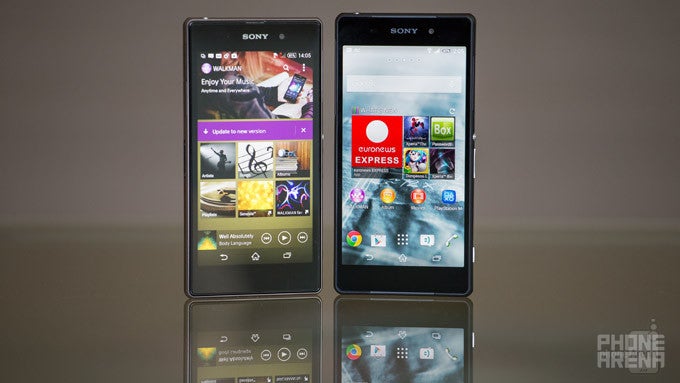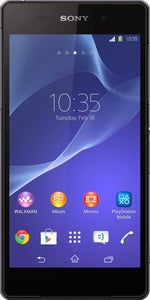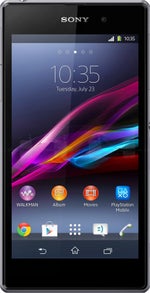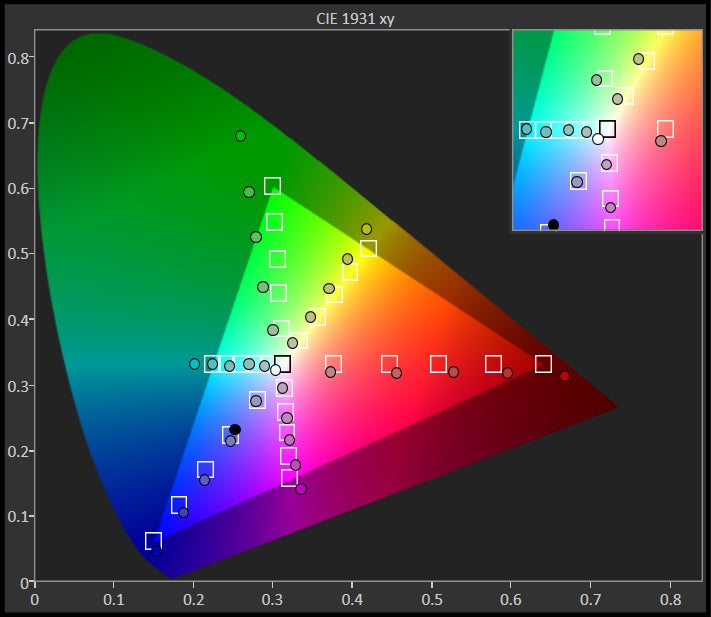Sony Xperia Z2 vs Sony Xperia Z1

Introduction
Ever since the Xperia Z, released last spring, Sony adopted a six-month upgrade cycle for its flagships, issuing the Z1 in the fall, and this spring it outed the Xperia Z2. Despite the bi-annual upgrade schedule, Sony significantly improved the Z2 over its predecessor. Although it's thinner and lighter, the new heavyweight boxer features a larger, better 5.2-inch IPS display, a larger battery and faster chipset, paired with the generous 3 GB of RAM. Its 20.7MP camera on its back is capable of 4K recording, slow-motion video, and adding real-time effects now. In addition, the Z2 one-ups the Z1 with a stereo speaker set, as well as noise cancellation, plus a few more software and hardware extras.
These are the dry facts about the upgrades that happened between the Z1 and Z2, but is their performance level all that different? Let's dive in for the nitty-gritty details in the fight between the six-months old Z1, and its overhauled successor the Z2...
Design
With a very similar waterproof chassis, the Z2 still feels more comfortable to hold and operate.
Measuring at 0.32” (8.2mm) thickness and 5.75oz (163g) of weight, Sony's newest flagship is a tad thinner and narrower than the Z1 predecessor, and it's also a bit lighter. Of course, that 0.2” larger display diagonal had to go somewhere, so the Z2 is slightly taller than the Z1. The Xperia Z2 is still crafted in the best traditions of Sony's OmniBalance design, with glass front and backplate, clasped into a sturdy one-piece aluminum frame, exuding a premium feeling.
Both handsets offer a rectangular unibody chassis with IP58 waterproof certification, sealed battery, and all the ports and slots on the sides are covered with protective flaps. The IP58 tag means that they can stay in up to five feet (1.5m) of water for more than an hour, so you'd have no issues using them in the rain, the shower, or even in the bathtub. The corners of the Z2 chassis, however, are a tad softer than the Z1's, and the sides are more tapered, so it feels a bit better in the hand. The round metallic power/lock key, the volume rocker, and the shutter keys on the phones' right sides are all easy to feel and press without looking, and offer good tactile feedback. The protective flaps over the SIM and microSD card slots, as well as over the microUSB ports, however, are a bit of a nuisance to pry open on both the Z1 and Z2, especially with trimmed fingernails, but that's the price to pay for being able to dunk the phones in five feet of water.
One of the significant differences between the Z1 and Z2 is that Sony graced its latest flagship with stereo speakers and amplifier set, dubbed S-Force Front Surround Sound. They are located at the top and bottom of the handset, making it one of the only handful of smartphones with a stereo speaker combo.
Display
We finally get a great display on a Sony flagship, and Z2 is the one carrying the torch here.
The Z2 has quite a different, 5.2” 1080x1920 display panel with very good 424ppi pixel density, compared to the 5” 1080p display of the Z1, which sport the slightly higher 441ppi count. The 5.2" panel of the Z2 is still called a Triluminos display, but is based on IPS and sports a new pixel imaging technology, compared to the “quantum dots” in the Z1. It is dubbed Live Color LED, and combines red and green phosphor with blue LEDs for the backlighting, with tailored color filters on top that should produce brighter and more evenly-spread lighting.
Sony brags that the new display tech in the Z2 allows for a wider color gamut coverage and vivid imagery, but at the same time avoids the unpleasant oversaturation that we've come to associate with, say, AMOLED displays. Looking at our own display measurements, the color chart shows that indeed the Z2 display's colors mostly fit into the standard RGB gamut space, and are evenly distributed there, save for the greens, which extend beyond the sRGB frame, appearing a tad richer than the reference, but still not gaudy to look at. We are talking about what you will be seeing around the interface and in most apps here, as when you enter the gallery, or watch a movie, Sony's default X-Reality for Mobile engine kicks in. It is supposed to “optimise colours, sharpness and contrast,” but in our test photo it distorted the colors.
A similar distortion effect can be observed on the Z1, but its green color fits better inside the sRGB gamut range than the hues on the Z2, with or without X-Reality. Thus, if you want a more even and natural color representation while watching pics or video, we'd advise to turn off the X-Reality engine on both handsets. As for the color temperature, we measured the white point of the Z2 to be pretty close to the reference (6950K), unlike on the Z1's display (7350K), whose colors tend to go over to the cold side of the spectrum.
When it comes to peak brightness, we measured 454 nits from the Z2, and 495 nits on the Z1, which is in line with a good LCD display, but nothing spectacular. Outdoors both phone screens are average performers, as their display coatings still reflect quite a lot of light back to your eyes, making their sunlight visibility as poor as on most smartphones out there. The weakest spot of the Z1 flagship is its 5" display panel, whose viewing angles are far from the flagship level, but on the Z2 we have an IPS-LCD screen, so this point is now moot, as the display's brightness and saturation barely budge even at extreme viewing angles.
Interface
With extra gestures and features, the Xperia UI on the Z2 has an edge over the software on the Z1.
The phones carry Sony's newest Xperia interface overlay, coated over Android 4.4.2 KitKat. Compared to previous Xperia UI iterations, the status bar, and its Quick Settings, have been reworked to become clearer, and more intuitive. Also, the new launch animation and the live wallpaper have been borrowed from thePlayStation 4, but you also have Sony's Xperia Themes with downloadable UI packs from Sony Select that let you customize up to 280 items from the Xperia Android interface in a variety of styles.
Furthermore, Sony's native Android apps, such as Messaging, MyXperia, Smart Connect, Small apps, TrackID, TrackID TV, Sony Select, Smart Social Camera have received updates as well, while the Media apps (Walkman, Album, and Movies) are now integrated with Sony Entertainment Network and PlayMemories. There is also a "What's new" app with its own homescreen widget, that serves as a recommendation engine for apps, media and feeds.
The Z2 interface overlay, however, offers a few more functionality improvements than the Z1, like DoubleTap to Wake, and a Smart Call function that lets you answer calls with gestures, as well as new extras in the camera interface, which we will list below. With the Xperia Z2 you are finally able to answer a call by just bringing the phone to your ear. The feature is enabled from the Smart call handling setting on the Z2, and has been present on phones from other manufacturers for a while now, just as the double-tap-to-wake option, so Sony is just bringing its flagship up to speed here.
Processor and memory
When it comes to 3D gaming and multitasking, the Z2 takes the helm in processing power, but still you won't be disappointed from both Sony phones' performance.
The screen is not the only thing that's better in the Z2, compared to the Z1. Sony's finest comes with a 2.3 GHz quad-core Snapdragon 801 chipset with LTE support, paired with the fair 3 GB of RAM, while in the Z1 we have 2 GB. In comparison with the 2.2 GHz Snapdragon 800 in the Z1, the 801 chip comes with 14% faster Krait 400 processor cores, and 28% faster Adreno 330 graphics. Even more important - we have dedicated image signal processors with it, for a 45% improvement in camera sensor processing speed, allowing Sony some new image and video capture trickery that the Z1 doesn't have.
When it comes to the interface and apps, both handsets perform well, without noticeable lag or hiccups, though the Z2 appears slightly more fluid in everyday interaction. Its graphics performance scores much higher on the standard benchmarks, though, while heavy 3D games like Aspahalt 8 also seem to load faster, and run with richer graphics. Sony starts you off with 16 GB of storage on the handsets (12 GB user-available), but offer a microSD slot for memory expansion, too.
Internet and connectivity
The Z2 sports more LTE bands than the Z1, including the ones for US carriers.
Sony uses Android's default Chrome browser on the Z1 and Z2, whose performance is seamless when it comes to panning, scrolling or zooming on both handsets. Granted, we have a slightly lower pixel density on the Z2, but it can't be noticed while reading small text in the browser, for instance, as 424ppi is still plenty enough for any purpose.
The phones offer up to 42 Mbps HSPA+ download speeds with pentaband support, which includes the 1700 MHz spectrum of T-Mobile in the US as well. They also have 4G LTE modems, which in the case of the Z1 is octa-band, while the Z2 throws in two extra bands for US carrier support from the get-go. The handsets also offer a rich set of other wireless connectivity options, too, such as Wi-Fi, Wi-Fi Direct, Bluetooth 4.0, A-GPS, and Miracast connectivity, plus NFC. Wired connectivity is supplied via the MHL port at the left side of the handsets for TV-out purposes.
Camera
With the same sensor/lens combo, the Z1 and Z2 produce very similar photos, but the Z2 takes the reign in video recording and extra camera options.
Sony uses the same 20.7 MP camera sensor in both handsets, but enables 4K video recording from the get-go in the Z2, making it what Sony claims as "the world’s best camcorder in a waterproof smartphone". Both phones offer 2 MP front-facing cams, capable of 1080p video recording. Despite that both rear cameras use the same 1/2.3” Exmor RS image sensor with 1.1 micron pixels, and Sony G Lens, Sony has leveraged the faster processor and more RAM in the Z2 for extra camera functions, added as new options in the otherwise almost identical camera interfaces. The still shots are getting a new trick, called Background defocus – it captures two photos at different focus settings, and blends together the different depths, leading to a blurred-out background for more artsy photos, similar to what the Galaxy S5 and HTC One (M8) do, but with less depth levels. Both phones sport the so-called Creative effects, where you can add coloring, image trails, mirror and motion effects, as well as augmented reality scenes to the stills and the video.
Photos from the Z1 and Z2 share largely similar characteristics, which is quite explicable, given the same sensor/lens combo. There are subtle differences, though, such as the fact that the Xperia Z2 slightly oversaturates the colors, compared to the real image in front of the lens, and its photos have slightly softer look.
The two phones nab the correct exposure settings most of the time, striking a good balance between shadowy areas highlight, and “burn” avoidance of brighter objects. The Superior Auto mode chooses whether to shoot in HDR regime automatically, and uses fill flash where needed with very good results. . Both handsets capture a very good amount of detail, though the Z1 sharpenes the finer detail better. We guess software update of the still new Z2 may tweak the post-processing to deliver sharper images. If you want the full 20 MP resolution, you'd have to use the Manual mode, as in the default Superior auto mode, the phone captures 8MP 16:9 photos, but these come with less noise and visual artifacts. We believe this is the better mode for Z2 and Z1 and we used it for most of our shots.
The indoor shots are about on par in terms of quality, sporting natural color representation both in terms of saturation levels, and true-to-life white balance that doesn't lean on the cold or warm side in most scenarios. Detail is plenty, and the noise levels are kept under wraps even when the light dims down significantly. Still, we like the Z2 test shots better, as they sport a bit more uniform color representation in different lighting scenarios, and a tad less noise. Also, the LED flash of the Z2 did a better job when shining light on our test scene from about five feet (1.5m) distance, producing a more evenly distributed illumination than the center splash that occurs with the Z1.
We already mentioned the ability of the Z2 to shoot 4K footage with 30fps, compared to 1080p for the Z1. Sony also adds its Timeshift option for videos in the Z2, not only for stills. Moreover, you can shoot 120fps 720p footage, and select where it should turn into slow-motion one, for some extra drama. Add to these the real-time effects you can apply during shooting, like coloring, image trails, mirror and motion effects, as well as the augmented reality options you can choose before you press the camera key, and the video aspect all of a sudden becomes dramatically upgraded from the Z1. You are now able to create short and sweet Vine video clips directly from the camera interface, too, and underwater at that, if the situation calls for it.
The 1080p footage from the handsets is clean, fluid, and without skipped frames, or annoying artifacts. We like the Z2 videos a bit better, though, as they look a tad smoother, and more vivid. Continuous autofocus works very well with both handsets, but again the Z2 refocuses back and forth slightly faster. The 4K footage possible with the Z2 offers a breathtaking amount of detail, too, something that the stock Z1 isn't able to produce.
Multimedia
As the Z2 enters the elite club of phones with a stereo speaker set, it offers audio experience superior to the Z1.
Sony uses its Album app in place of a stock gallery on the Z2 and Z1, offering plenty of picture editing modes that can be used from within the app's interface. Your video collection goes in the Movies app, which also boasts a pretty interface with footage previews. There is an interesting Track ID TV mode, which serves as Shazam for video, pulling out information about the movie currently on TV based on the sound recorded from it.
The Xperia interface has one of the nicest music players from all manufacturer overlays out there. It is Walkman-branded, and offers a very appealing and easy to use interface, with plenty of categorization options and sound modes to choose from. The Xperia Z2 ups the Z1 game significantly in the audio department. Sony put stereo speakers and amplifier set in the Z2, dubbed S-Force Front Surround Sound. The waterproof speakers do sound better compared to the single speaker of the Z1, but the comparable BoomSound set on the HTC One (M8), for instance, has better clarity, and a more rounded sound. Also, the strength leaves something to be desired on both handsets – we measured 71dB on the Z2 vs 68dB on the Z1, which is nothing to write home about.
The Z2 also comes with a digital noise-cancellation technology in headset mode. The special in-ear headphones have microphone built-in, but unlike traditional active noise-canceling headphones, the DSP processing is done in the phone itself, instead of in the headphones. Thus the set doesn't have to have batteries, and Sony claims that the results are better. You can easily hear the active noise-canceling effect, and it works pretty good, but in most markets they don't ship with the phone, and you'd have to buy the special headphones separately.
The default video player on the Z1 and Z2 runs every popular format you throw at it, including DivX/Xvid/MKV files, up to 1080p in resolution. It also sports plenty of settings, like a loop mode, or subtitles support. The footage looks prettier on the larger display with wide viewing angles of the Z2, though.
Call quality
We can call these two the “average performers,” as neither their earpieces, nor the mics can muster anything extraordinary.
The handsets muster just an average call quality, both in the earpiece, and through the microphones. The Z2's earpiece is strong enough, but the voices are coming in a tad grating and unnatural. The Z1's earpiece loudness is just enough at the high volumes, and you can easily recognize the caller's timbre. The two noise-canceling mics of the Z2 are able to weed out the ambient noise, but relayed our voice to the other end hollow and flat, though with an adequate volume. There is a second mic on the Z1, too, which is used for noise-cancellation, so your callers can make out what you're saying even if you happen to be in a noisy environment. On the other side of the line, callers are mostly pleased by what they hear from the Z1, getting our voice in a strong and fairly clean manner.
Battery
Sony managed to sneak a large, 3200 mAh battery, in the 8.2mm chassis of the Z2, compared to the 3000 mAh piece in the Z1. This capacity is more akin to a phablet, and Sony promises "outstanding, class-leading battery performance," citing the Z2 juicer as good for 19 hours of talk time in 3G mode, against 15 hours for the Z1.
The screen-on times we measured with the Z1 in our battery test were unimpressive, at less than five hours. The 5.2" IPS-LCD display on the Z2 is made with a more modern technology than the power-hungry TN-LCD unit of the Z1, however, which translates to better endurance. Sony cites 6-7 hours of HD video watching on a charge, so the Z2 won't break any battery life records, as this is just an average screen-on duration for an Android flagship. We will update this section when our battery life test with the Z2 is done and dusted.
Conclusion
With a larger, better display, faster processor, longer battery life, stereo speakers, and 4K video recording, the Z2 looks like an obvious pick before the Z1, especially considering that it is housed in the same footprint. Do these enhancements warrant the 150-200 USD or EUR price difference, though? Based on our thorough rundown with the two phones, we'd have to say yes.
The main reasons to upgrade to, or pick the Xperia Z2 before the Z1, are the better battery life, and the much improved display, which are now in line with the flagship category of the handset, instead of lagging behind the competition. Even if you don't really care about 4K video recording and real-time effects, the camera of the Z2 sports zippier performance that produces a tad better photos in some conditions than the Z1, despite that it uses the same sensor.
Overall, if you can afford the Xperia Z2, get it, but if you'd like to save a Benjamin or two, there will be better alternatives at that price point than the Z1. If you already own a Z1, and are considering an upgrade, the move to the Z2 will be worth the price difference, as you will be getting more in every aspect, and the most glaring omissions of the Z1 now stand corrected with the Z2.






























Things that are NOT allowed: